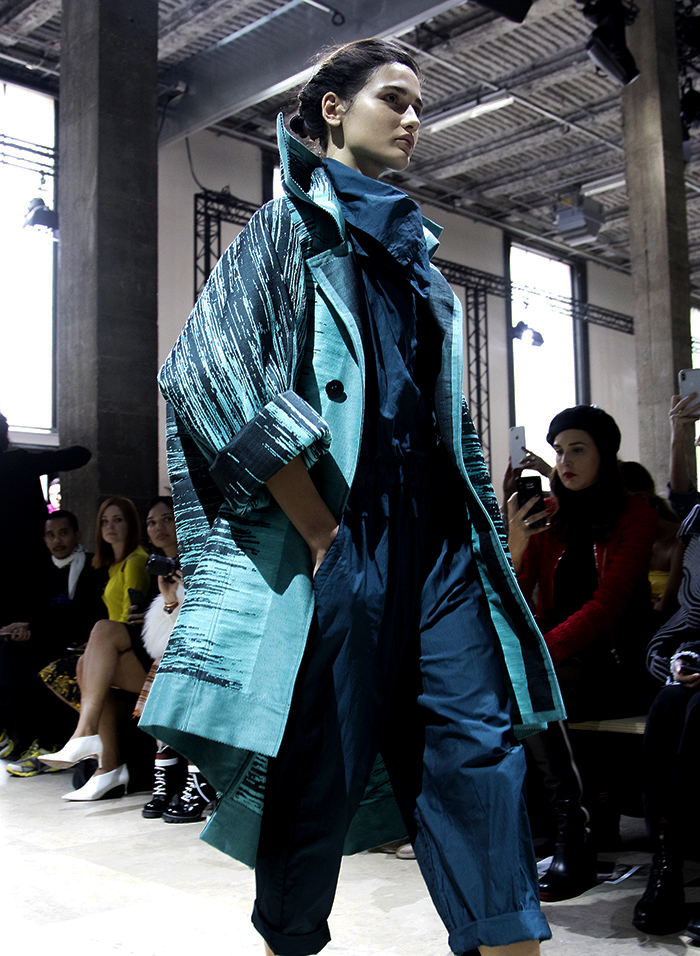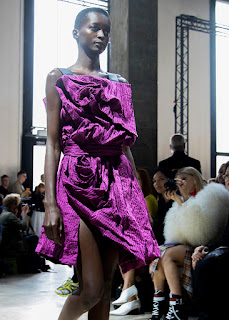French couturier Jean Paul Gaultier presented one of his best new collections in Paris, with inspirations from sea creatures to Japanese kimonos. This lively Spring/Summer 2019 haute couture show is also the culmination of his work outside fashion including his successful cabaret at the Folies Bergere and a new documentary about the theatrical show, writes Elli Ioannou
 |
| Dita Von Teese walks the runway for Jean Paul Gaultier in Paris |
The designer said this collection was inspired by all things related to the deep sea and Japan. Many of the gowns' colour, texture and swirling movement reflect the hue and watery swirl of seaweed, coral and jellyfish. There was also a distinctly Japanese aesthetic mixed with high, pointy shoulders that Gaultier describes as "shark fins".
"There are some Japanese influences that are quite fascinating," the designer said backstage. "There are also lots of pleats ~ the whole collection is pleated ~ I even made pleated thigh boots." The key themes of the collection are transparency, pleats, 3D details and Japanese paniers. Gaultier also took the underwired corset and twisted it into new forms. "Normally the structure of crinolines is well behaved but I turned them around and spread them out," he explains. "We worked with three dimensions, especially with the embroidery. Inspired by Japan, the Japanese obi becomes a piece of clothing with reliefs that are in three dimensions with layers of bubbles. We play with transparency while using really light fabrics."
"There are some Japanese influences that are quite fascinating. It’s also full of pleats ~ the whole collection is pleated and I even made pleated thigh boots"
 |
Deep sea blue gown with diaphanous
pleating from shoulder to ankle
|
Mr. Gaultier is well known for his signature French sailor look, the Breton top, and he created a new iteration of this for the opening look of the couture show with a diaphanous, striped blouse and a long, filmy gown in deep blue, pleated from the peaked shoulders down to the swirling skirt (see at right). Other motifs included beautiful pinstriped suits and shell-like dresses with the corset structure seen beneath transparent fabrics.
The clever mix of fan pleats, high shoulders and stripes gave depth and three dimensionality to the whole collection. A black-and-white dress had stripes running up from the ankle to curving around one shoulder, that was deceptively simple but showed Gaultier's superb skill as a couturier (see below in the gallery).
The designer's muse Anna Cleveland, who is also featured in the cabaret show, wore an organza, pleated gown with full sleeves and long, dark lapels (see below). Like the other models, she had vividly coloured, crimped hair that added to the sense of magical, sea creatures covered in sparkling jewels.
Overall the collection ranged from sailor shirts to corsets with hand-made details created in Mr. Gaultier's ateliers. Most of the suit jackets had the pointed "shark fin" shoulders and pleats were fanned across belts and ruffled along the top of tall boots. The sculptural corset dresses were overlaid with floating, opalescent fabrics and the brightly coloured striped pantsuits were mixed with long, draped gowns. The punk geisha girls wore gleaming, bright fabrics with high waists and big bow ties.
 |
| Anna Cleveland wears the signature quirky Gaultier wedding dress |
Mr. Gaultier has found that his iconoclastic aesthetic, that shocked audiences as a young designer, is now part of the zeitgeist. His early collections worn by men and women featured models of different shapes, ages and ethnicity.
He broke down stereotypes ~ but it has taken decades for the rest of the fashion world to catch up.
The designer originally trained with Pierre Cardin and later at the Jean Patou fashion house. By the time he started out on his own in 1976, he already had a taste for runway shows that showed a wide range of different models who exuberantly wore his avant-garde designs. By the early 1980s, Mr. Gaultier had become well known for playing with traditional gender roles and his work inspired by streetwear and popular culture plus his use of models who were androgynous and tattooed and often didn't fit the rake thin frame considered the ideal in fashion.
Jean Paul Gaultier's iconoclastic androgynous aesthetic as a young designer is now part of the zeitgeist
 |
| Japanese inspired creations were one of the designer's key motifs for the new SS19 collection |
The cabaret show is produced by music producer Thierry Suc for the Folies Bergères and has had a full house every night since it opened to the public last October, now to be extended until late April 2019. Mr. Suc, who has worked with some of France’s best known musicians and artists, has said the show will be taken around the world, and depending on the country, will be adapted to appeal to local audiences.
Mr. Gaultier approached Thierry Suc with the idea of the show and the pair worked together to create a cinematic experience combining cabaret with fashion shows and film.
Cesar-winning Tonie Marshall co-directed the show and worked with Marion Motin, a dancer and choreographer who’s previously worked on Madonna concerts. Nile Rodgers, who has worked with Diana Ross, David Bowie, Madonna and Daft Punk, created the soundtrack for the Fashion Freak Show. The designer says the music from disco to funk and from pop to rock and new wave is a playlist that has inspired him throughout his life.
By the early Eighties, he was playing with traditional gender roles and drawing inspiration from streetwear and popular culture
 |
| Black and white elegance is is given an avant-garde edge with leather and fine pleating |
Some of the cabaret's scenes show the designer's early fashion shows that were more like theatrical events, given even more of an edge by his punk aesthetic and use of recycled materials. Mr. Gaultier believes it is a new form of theatre that combines both a revue and a fashion show and includes actors, dancers and circus performers with dozens of specially designed new outfits.
He wants to take the audience on a journey from his childhood and early career to his most flamboyant fashion shows and nights spent at Le Palace and London.Video is part of the show and includes Catherine Deneuve plus Anna Cleveland, one of the show's ensemble cast, who makes striking, styled poses.
Like Mr. Gaultier's haute couture show in Paris, the cabaret at the Folies Bergere is suffused with the couturier's joie de vivre and creative energy that seems to reach out and embrace everyone both on stage and the runway and also those in the audience standing up in the aisles dancing and clapping to the pop anthems.
Tap on the gallery of photographs to see more highlights from the collection
 |
| A classic pinstripe suit completely reimagined into a charming folly with a pleated belt, curving poplin jacket lined in bright pink with matching tights |
 |
| Turning Japanese, Jean Paul Gaultier's inspirations from Japan with the obi and strongly patterned, bright fabrics |
 |
| Pleated, high boots in sea greens and a crinkled, colourful hair were standouts in the collection |
 |
| Fine pleats were even used to create 3D belts, here on leather trousers worn with a short white jacket and filmy, striped blouse |
 |
| "Shark fin" shoulders were a leitmotif of the entire collection adding zest and drama to jackets and dresses |
 |
| Sea creatures were the inspiration for many of the gowns including these fluid concoctions in Coral Pink and swirling Seaweed Green |
 |
| A tuxedo jacket is given a quirky edge with it's pointy, one shouldered design and its mix with a pleated short skirt and long boots |
 |
| Coral hues and the colours of the deep sea gave the collection both depth and cohesion |
 |
| Anna Cleveland wears a white, finely pleated gown with long lapels like a haute couture martial arts outfit |
 |
| The brilliant simplicity of stripes from the ankle curving up over the shoulder, a tour de force of couture skill |
 |
| The use of superbly fine pleating on this blouse's shoulders and cuffs creates an elegant yet striking look |
 |
| Coco Rocha wears a pale, sea blue hooped turquoise organza dress that seemed to move like a sea creature in water |
 |
| Who knew sharply pointed shoulders and finely pleated, high boots would make such an engaging combination? |
 |
| Jean Paul Gaultier took is signature run down the catwalk before stopping to smile at this guests |

















































